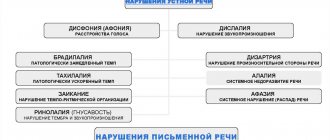In this article we will look at the key concepts: “environment”, “speech”, “speech environment”.
The concept of “environment” is considered in different fields of science. We are primarily interested in its pedagogical interpretation. In O.V. Dybina we find the following definition: “environment is the surrounding space or zone of direct activity of an individual, under the conditions of which the formation and development of personality occurs.”
Let us turn to the consideration of the concept of “speech”. L.A. Samusikova gives the following interpretation: “speech is a system of used sound signals, written signs and symbols used to transmit, process and store any information.”
The concept of speech environment
The speech environment is the speech that a person perceives in natural conditions: the language of the family, radio, television, the language of books, etc.
The speech environment is a natural environment, rationally organized, saturated with a variety of sensory stimuli and gaming materials. The speech environment surrounds a person everywhere. Both personal and public life involve the active use of speech
The competent organization of a child’s speech environment makes it possible to have a powerful educational impact, which is aimed at developing cognitive relationships aimed not only at the surrounding world, but also at the language system, thereby developing basic ideas about the native language and native speech.
Therefore, it is believed that the main direction for increasing the effectiveness of approaches to the formation of speech in preschoolers is the organization of the speech environment.
The speech environment is a concept that includes many elements. This includes all possible language patterns that are perceived by the child: not only the communication of people around, but also the speech heard on radio and television.
L.P. Fedorenko introduced the term “developing speech environment” into scientific circulation. By this concept he meant an environment that activates the process of development of speech communications. This is an environment that reveals the speech potential of children. It does not arise on its own, but is the result of a purposeful sequential action aimed at communication impact.
The speech environment in kindergarten is the speech surrounding children within the children's educational institution. The speech environment can also include a targeted impact on speech development, which is expressed in various program forms used by teachers.
A newborn needs communication
It may seem strange, but speech begins to develop before the child is born: he hears the internal and external voice of the mother.
Therefore, it is very important that this voice carries only a positive beginning - it is calm and joyful. In the first weeks of life, the baby, without responding in any way, listens carefully to speech. Then he begins to hum and make short sounds, which are a consequence of interaction with the outside world and people; later, emotionally rich sounds and babbling speech appear. Attentive attitude on the part of adults to the voice exercises of a newborn helps to shape future communication skills and the need to express one’s thoughts. It is important for parents to constantly talk to their baby, thus preparing his vocabulary.
The role of the educator in the formation of the speech environment
The teacher’s speech is the main means of teaching and shaping preschoolers. Didactic communications are the basis of the speech environment, which can have great potential for the development of children's speech.
L.P. Fedorenko divides the speech environment into two components: this is a natural communicative environment, these are free conversations with peers and this is an artificial speech environment. Let's look at all these types in more detail.
A natural communication environment arises without the teacher’s efforts, on its own. But at the same time, it has an impact on the formation of the child’s abilities. It has a positive effect on mental development and the formation of speech abilities.
This happens if those who communicate with the child are those who have correct speech, who react to the preschooler’s statements and answer the children’s questions. But this environment can also be negative if adults do not pay attention to the child’s statements and do not communicate with him. Often such children develop speech defects.
This includes not only communication with teachers and parents, but also any communication of the child with people of different ages.
1.3. The importance of timely speech formation for the comprehensive education and development of children.
Timely mastery of correct speech is important for the formation of a child’s full-fledged personality, for his successful education at school and for further work activity. A child’s speech develops in the process of communicating with others. Therefore, the clear speech of those among whom the child is located is very important, as well as control and proper guidance of the formation of his speech, which in its development goes through certain stages: expressive-facial, objective-effective and speech.
The main significance of speech in the mental development of a child is that it frees him from being bound by the situation, momentary events and opens up the opportunity to act not only with things, but also with their substitutes - signs embodied in words; expands the time perspective of the baby’s life, allowing him to look into the past and future.
Speech helps the child free himself from “naturalness” in relation to the objective world: it begins to appear before him as a world of objects of human culture. Speech allows the baby to get to know him not only through personal experience, but also through words. Through verbal communication with adults, the child learns about what he himself did not directly perceive.
Timely development of speech ensures that the child deepens and expands mutual understanding with both relatives and strangers. Speech expands the boundaries of a child’s social existence. Through a new attitude towards an adult not only as a source of warmth and care, but also as a model, a bearer of human culture, he moves out of the narrow framework of exclusively individual connections into the wider world of human relationships.
Mastering speech allows a child to overcome the limitations of situational communication and move from purely practical cooperation with adults to “theoretical” cooperation—non-situational-cognitive communication. The appearance of speech rearranges mental processes and activities.
It changes the nature of the child’s perception of the environment: it becomes independent of the external positions of the object, of the method of its presentation. At this age, children recognize and name images of objects, people, animals in drawings, photographs, and films. The influence of speech on the development of a child’s thinking is invaluable. At first, the baby does not know how to think using words without relying on a visual situation. Words only accompany an action or state its result (for example, seeing a fallen doll, a child says: “Lala fell”). In the third year of life, his speech is increasingly freed from the dictates of the visual situation. With the help of speech, he makes generalizations, draws conclusions, and begins to reason. Now the baby can not only discuss specific actions with objects or what he sees in front of him, but also talk about his experiences, remember episodes from his life, and plan future events. Gradually, speech becomes the basis for the development of voluntary behavior and begins to perform a planning function. For example, a child tells his mother that he is going to build a garage for a car, or tells a doll about what they will do: “Now I’ll make you soup, then we’ll eat.” In many situations, the word becomes a means of controlling and managing behavior. For example, a two-year-old child, going to carry out an order for an adult, repeats himself. to myself: “I’m going, I have to go.” In another situation, with difficulty moving a loaded toy car, he tensely says: “Drive, drive, Kolya.” (3,292-297), (4,91-95), (5,131-136)
Free and artificial speech environment
A free speech environment is an environment of communication with peers and teachers. Communication inevitably arises during sensitive moments in kindergarten. While walking, during everyday activities, while working or playing, children inevitably communicate with each other.
It is important to use the full potential of play to form the speech of preschoolers.
An artificial environment is an environment that is organized by a teacher to achieve specific tasks and using certain techniques and methodological tools. This allows you to reveal all your formative potential and direct it in the right direction.
Methodological means are training. Training refers to a specially organized process that occurs systematically so that children can acquire certain speech skills.
Learning involves the use of various pedagogical means, such as joint reading of literary works, familiarization with illustrations in books, holding conversations or activities, joint entertainment and holidays.
The environment that shapes a child’s speech is an environment that is specially organized to influence different speech aspects of a preschooler’s development.
This environment is organized for a specific purpose: to fill the surrounding object space with those components that would have a positive impact on the formation of children's speech.
Certain requirements for the speech of adults around the child
The speech of surrounding adults must be correct and must become a standard for the child, since speech skills are formed by imitation, and the assimilation of speech standards occurs spontaneously. Therefore, if adults, due to some circumstances, pronounce words incorrectly (“jacket” instead of “jacket”, “towels” instead of “towel”, “lost weight” instead of “lost weight”, “button” instead of “button”), the accents are placed incorrectly in words (“understood” instead of “understood”, “we’ll call you” instead of “we’ll call you”), they use incorrect forms of the word (“lay down” instead of “put down”), then there is a danger that the child will learn the wrong version of speech, which will become fixed over time. For the same reasons, it is necessary to exclude “lisping”.
The general requirements for adult speech are as follows:
- speech is clear, without speech disorders;
- clear pronunciation of words, with exaggerated articulation of sounds, highlighting the stressed syllable;
- simple short phrases of 2–4 words;
- frequent repetition of the same words, phrases, sentences;
- the use of different intonations, different voice strengths, correct placement of pauses.
Gradual complication of verbal communication
Gradually, the child’s level of verbal communication develops and becomes more complex. To use these new opportunities, it is necessary to gradually change the level of requirements for the baby’s speech. But it is important that the requirements correspond to the level of development; it is harmful to overestimate (constant “Say!”, “Repeat!”) or underestimate (immediate fulfillment of any desire) them. Organization of special speech games and exercises. The form of play is the most effective method of teaching young children. Therefore, what was said during the regime moments can be consolidated in a specially created game, where the main characters will be different dolls, soldiers, and little animals.
Tasks of the speech environment
There are the following tasks of organizing the speech environment:
- give children the opportunity to perceive and observe someone else’s literate speech;
- development of sensory concepts;
- independent speech activity of a preschooler;
- comfortable emotional state of children in the process of verbal communications;
- the child has the opportunity to experiment and observe the language system.
There are the following components that make up the RRS: special equipment, working methods and teacher speech.
Thus, following L.P. Fedorenko, we will consider the speech environment as an environment that stimulates speech communications, an environment in which the developmental potential does not develop spontaneously, but is systematic and consistent in nature, directing communicative activity.
Related posts:
- Features of creating a speech environment in preschool educational activities Creation of a speech environment - features of the organization, why a well-organized...
- Implementation of the conditions for designing a developing educational space using modern gaming technologies Conditions for designing an educational space in kindergarten using gaming technologies….
- Pedagogical conditions for creating a speech environment in the preparatory group of a kindergarten Conditions for creating a speech environment in a preschool educational institution. Techniques and methods of organizing...
- Teaching children to read and write - methods and techniques Teaching literacy in the process of play activities - play situations, didactic...
Factors determining the need to change the educational program
- The focus of the school’s educational work system is on the formation of a St. Petersburger: the image of an intellectual, a true St. Petersburger, is primarily associated with a high level of speech culture.
- The state of the modern speech and language environment, characterized by researchers in this field as an environment characterized by contradictory trends: on the one hand, substandardization, lumpenization, manifested in the unjustified use of barbarisms, jargon, colloquial vocabulary, etc., and on the other hand, an increase in the personal element in speech, rejection of bureaucratic language, searches for new means of expressiveness and imagery of speech, spontaneity of speech not only in direct communication, but also in the situation of oral public speaking, which requires a high level of speech skills.
- The discrepancy in the criterial norms of good and correct speech among different groups of the population, which can also manifest itself in the discrepancy in the criterion norms of participants in the educational process: students, parents, subject teachers and teachers of Russian language and literature.
- The relevance of finding solutions to problems related to the development of language and speech in the post-industrial information society; a society in which it is not individuals who function, but social roles, which leads to a significant simplification of speech situations and linguistic formulas used and, as a consequence, to a simplification of the picture of the world as a whole.
- Heterogeneity of the student body. In accordance with existing legislation, everyone can be admitted to the school by application. The location of the school (an area predominantly built up in the pre-revolutionary era, an abundance of communal apartments, the mass relocation of the St. Petersburg intelligentsia to “dormitory” areas in the 70-80s) largely determined its current contingent. Another serious problem that determines the student population is the territorial proximity of gymnasiums with similar educational programs and the need to survive in a competitive environment.
- The absence in the educational program of well-thought-out methods for implementing continuity in the work of junior, basic general and secondary (complete) schools.
The creation of a developing speech environment is possible only if the actions of the entire teaching staff, a collective pedagogical subject, are coordinated, the relationships between the members of which have two main manifestations:
- continuity of teachers in primary, secondary and high schools;
- interaction between subject teachers from different methodological associations.


